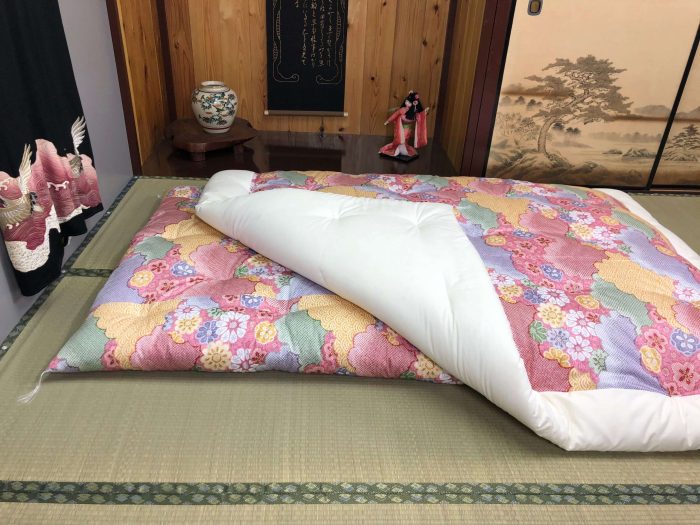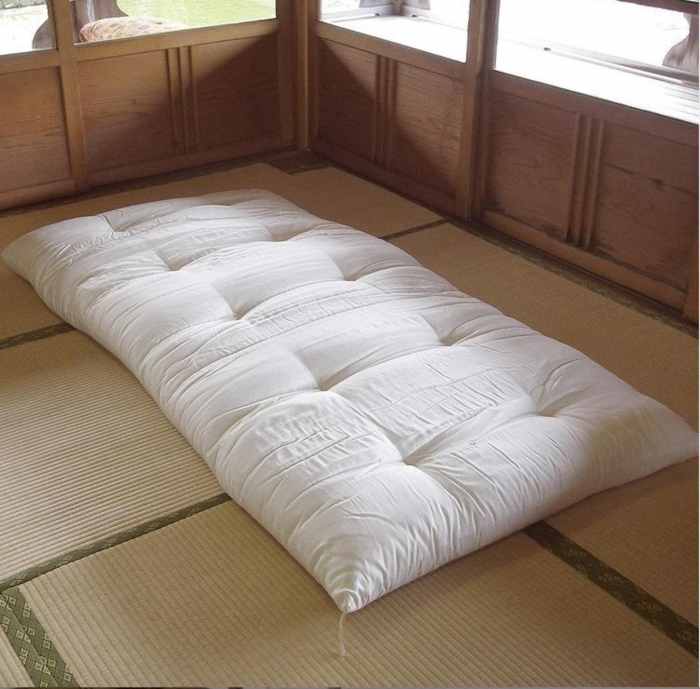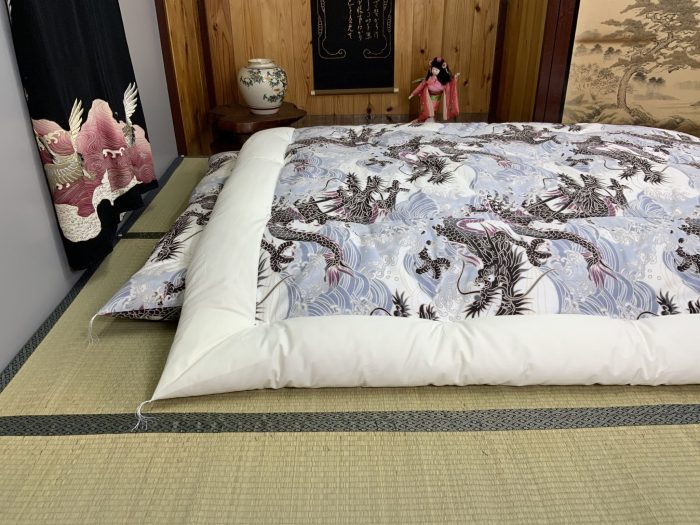Immerse yourself in the world of Japanese futons, a timeless tradition that seamlessly blends comfort, versatility, and cultural heritage. From their humble origins to their modern adaptations, futons have played a pivotal role in Japanese society, offering a unique sleeping experience and adding a touch of elegance to any space.
Discover the different types of futons available, ranging from traditional designs to modern innovations. Learn about the health benefits associated with sleeping on a futon, such as improved posture and reduced back pain. Explore the various ways futons can be used, from a comfortable sleeping surface to a stylish seating option.
Historical and Cultural Context

The Japanese futon, a traditional bedding system, holds a rich historical and cultural significance in Japan. Its origins can be traced back to the Heian period (794-1185), where it was known as “shikibuton” and consisted of layers of thick cotton batting placed on tatami mats.
Futons have always been an integral part of Japanese culture, reflecting the country’s emphasis on simplicity, comfort, and space-saving. The traditional materials used in futon making include cotton, silk, and wool, which provide warmth, breathability, and durability. The construction methods involve meticulous hand-stitching and layering of these materials to create a comfortable and supportive sleeping surface.
Evolution of Futon Usage
Over time, the futon evolved from being a luxurious item used by the elite to a common bedding system for all classes of society. During the Edo period (1603-1868), the use of futons became widespread, with commoners using them as their primary bedding on tatami mats.
In the 20th century, the introduction of Western-style beds and mattresses led to a decline in the popularity of futons. However, in recent years, there has been a resurgence of interest in traditional Japanese bedding, with many people appreciating the comfort, convenience, and cultural significance of futons.
Types and Styles of Futons: Japanese Futon
Futons come in a wide variety of types and styles, each with its own unique features and benefits. Traditional futons are typically made of cotton or wool and are filled with layers of batting. They are often used as bedding in Japan and are known for their comfort and support.
Modern futons have a more contemporary design and are often made with synthetic materials. They are typically thinner and lighter than traditional futons and are often used as sofa beds or guest beds. Specialty futons are designed for specific purposes, such as camping or travel.
They are often made with lightweight and durable materials and are easy to transport.
Japanese futons are renowned for their comfort and versatility, offering a firm yet supportive sleeping surface. Whether you’re looking for a cozy night’s sleep at home or a comfortable base for your next camping adventure, a futon can provide the perfect solution.
Explore our wide selection of camping mattresses to find the perfect fit for your outdoor escapades, and discover the exceptional comfort of a Japanese futon today.
Variations in Size, Thickness, and Firmness Levels
Futons come in a variety of sizes, from twin to king. The thickness of a futon can also vary, with thicker futons providing more support and comfort. The firmness level of a futon can also be adjusted by adding or removing layers of batting.
Japanese futons are traditionally thin, firm mattresses that provide excellent support and breathability. For those who prefer a softer sleep experience, a mattress topper can be added to the futon to provide additional cushioning and comfort. The topper can be made of various materials, such as memory foam, latex, or down, and can be customized to suit individual preferences.
By combining a Japanese futon with a mattress topper, you can create a comfortable and supportive sleep system that meets your specific needs.
Unique or Innovative Futon Styles
Some futons feature unique or innovative designs. For example, some futons are designed to be reversible, with one side made of a soft material and the other side made of a more durable material. Other futons are designed with built-in storage space, making them a great option for small spaces.
Benefits and Uses

Futons offer numerous health and practical advantages that contribute to their popularity as sleeping surfaces and versatile home furnishings.
In terms of health benefits, futons are renowned for promoting better posture and alleviating back pain. Their firm yet supportive surfaces encourage proper spinal alignment, reducing strain and discomfort in the back and neck areas. Furthermore, the natural materials used in futon construction, such as cotton and wool, provide breathability and moisture absorption, creating a comfortable and hygienic sleeping environment.
Versatility of Futons
Beyond their primary function as sleeping surfaces, futons exhibit remarkable versatility. They can seamlessly transition into comfortable seating options for relaxation or entertaining guests. Their foldable design allows for easy storage when not in use, maximizing space utilization in smaller living quarters.
Futons also serve as decorative elements, adding a touch of traditional Japanese aesthetic to any space. Their minimalist design and natural materials blend effortlessly with various interior styles, from contemporary to traditional. By incorporating futons into the décor, homeowners can create a cozy and inviting ambiance while embracing a touch of Japanese culture.
Care and Maintenance
Proper care and maintenance are crucial for extending the lifespan of your futon and ensuring its optimal performance. By following these simple steps, you can keep your futon fresh, clean, and comfortable for years to come.
Cleaning
- Vacuuming:Regularly vacuum the futon to remove dust, dirt, and allergens. Use the upholstery attachment to gently remove debris from the surface and crevices.
- Spot cleaning:For spills or stains, use a mild detergent mixed with water and a clean cloth. Blot the stain gently without rubbing to avoid spreading. Rinse the area with clean water and allow it to air dry.
- Professional cleaning:If your futon becomes heavily soiled or stained, consider professional cleaning. A professional cleaner can use specialized equipment and techniques to deep clean and restore the futon’s appearance.
Airing
Regular airing is essential to prevent moisture buildup and promote freshness. Take the futon outside on a sunny day and allow it to air for several hours. This will help dissipate moisture, remove odors, and prevent mold or mildew from forming.
Storage
When not in use, store the futon in a cool, dry place. Avoid storing it in a damp or humid environment, as this can promote mold growth. If possible, store the futon in its original packaging or a breathable cover to protect it from dust and dirt.
Tips for Avoiding Common Problems
- Mold or mildew:Keep the futon dry and well-aired to prevent mold or mildew from forming. If mold or mildew does occur, clean the area immediately with a solution of vinegar and water. Rinse the area with clean water and allow it to air dry completely.
- Dust mites:Dust mites can accumulate in futons, especially if they are not cleaned regularly. Vacuum the futon frequently and consider using a dust mite cover to reduce their presence.
- Sagging:Over time, the futon may begin to sag. To prevent this, rotate the futon regularly and flip it over occasionally to distribute the weight evenly.
Modern Adaptations and Innovations

Futons have evolved significantly to adapt to modern lifestyles and preferences. These adaptations include foldable designs, built-in storage, and the use of new materials and technologies.
Japanese futons are renowned for their comfort and versatility. For those seeking a more traditional sleeping experience, they offer an authentic touch. However, for those who prefer a more modern approach, consider exploring japanese floor mattresses . These mattresses combine the comfort of a futon with the convenience of a modern bed.
While they may not be as thick as traditional futons, they provide ample support and can be easily rolled up for storage. Ultimately, whether you opt for a classic japanese futon or a modern japanese floor mattress, you’re sure to enjoy a restful night’s sleep.
Foldable Designs
Traditional futons were large and cumbersome, making them difficult to store and move. Modern futons are often designed with foldable frames, allowing them to be easily folded into a compact size for storage or transportation.
Built-in Storage
Many modern futons feature built-in storage compartments, such as drawers or shelves. This allows users to store bedding, pillows, and other items within the futon itself, saving space and keeping the room organized.
New Materials and Technologies, Japanese futon
Advances in materials and technologies have also impacted futon construction. Some modern futons use high-density foam or memory foam instead of traditional cotton batting, providing increased comfort and support. Additionally, some futons incorporate heating elements or massage functions, enhancing relaxation and well-being.
Innovative Designs
Designers have also created innovative futon designs that cater to specific needs or preferences. For example, some futons are designed with adjustable headrests or armrests, allowing users to customize their comfort level. Others are designed with unique shapes or colors to complement modern décor.
Final Conclusion
In conclusion, Japanese futons are a testament to the enduring power of tradition and craftsmanship. They offer a unique blend of comfort, versatility, and cultural significance that continues to captivate people around the world. Whether you’re looking to enhance your sleep, add a touch of Japanese flair to your home, or simply appreciate the beauty of traditional craftsmanship, a Japanese futon is an exceptional choice.
FAQ
What are the different types of Japanese futons?
Japanese futons come in a variety of types, including traditional futons made from natural materials like cotton and wool, modern futons with synthetic fillings, and specialty designs like shikibuton and tatami mats.
How do I care for a Japanese futon?
To care for your Japanese futon, regular airing and sun exposure are essential. Avoid using harsh detergents or bleach, and store your futon in a dry and well-ventilated area when not in use.
What are the health benefits of sleeping on a Japanese futon?
Sleeping on a Japanese futon can provide several health benefits, including improved posture, reduced back pain, and better sleep quality due to the firm and supportive surface.